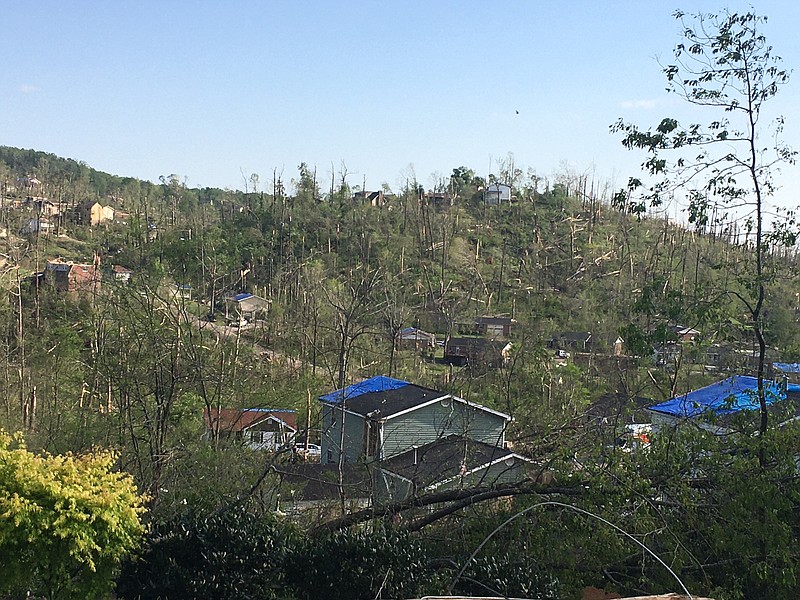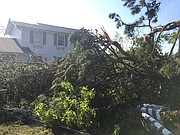For 20 years, Carol Green lived in a house surrounded by towering oaks, pines and maples on a steep, curving road in East Brainerd, secluded from her neighbors and set deep in the shade.
"All the trees are down," she said, surveying the newly desolate landscape after tornadoes scraped the suburban forests from hillsides across the area. "I've had all these wonderful trees, all this privacy, it was gorgeous. Now it's all gone."
Thousands of trees - toppled, split, twisted, blocking roads and crushing houses - are the focus of much of the massive cleanup effort following storms that devastated East Hamilton County, Bradley County and North Georgia late Sunday night and early Monday morning.
When it comes to cleaning up fallen forests, there's often a lot more to moving them than just firing up a chainsaw.
"Storm damage is a lot different than regular tree work," said Alex Rosser, owner of Cut Rate Tree Service, who has been in the tree business for 25 years. "If you don't know what you're doing, you'll get hurt."
Rosser, who was fielding 100 calls a day this week rather than the usual eight to 15, expects plenty of other tree services to come from other states to help with clean-up, and that's fine, as long as they are professionals, he said.
"Every tree service from five states will be here," he said.
Much of the risk in storm cleanup of trees rests in the unpredictable nature of a tree under pressure, Rosser said.
"When a limb is bowed up and you touch it with a chainsaw, it snaps and pops and explodes like a grenade," he said. "It's twice as dangerous as regular tree work."
Tips for getting the right help with tree clean-up
Contact your insurance company. Ask about your policy coverage and specific filing requirements. Your insurance company may also have recommended contractors.Do your research. Find businesses you can trust on BBB.org. Check your state or provincial government agency responsible for registering and/or licensing contractors. Get references from friends and relatives.Resist high-pressure sales. Some storm chasers use tactics such as the “good deal” you’ll get only if you hire the contractor on the spot. Disaster victims should never feel forced to make a hasty decision or to choose an unknown contractor.Source: bbb.org
The city's Public Works crews are getting help from tree-clearing pros to ensure they do the work safely, said Justin Holland, the administrator of the Chattanooga Public Works Department.
"There are lots of trees we're having to cut and push out to the road, and there are several contractors out assisting the city and our forestry crews," he said. "They are doing a phenomenal job providing expertise to homeowners and our own crews, who don't normally have this many trees under tension.
"There's very few people who do that type of work regularly."
Public crews are responsible for moving trees and other debris to clear blocked roads, but property owners are responsible for getting debris from their yards to the curb for pickup, Holland said.
"We don't come onto private property, but we will collect from the side of the road," he said. "People don't need to call in for brush collection - we will have a very coordinated effort to pick up from everybody's house."
In most cases, insurance will only cover tree removal if the tree has damaged a structure, whether it's the house or a fence or outbuilding. Trees that fall without damaging a structure become the homeowner's financial responsibility.
"Insurance said if it's not structural damage, insurance doesn't cover it," said Green, who is confronting the dilemma of how to get dozens of fallen trees on her property to the crub for pickup.
As homeowners start assessing the damage and seeking help with clearing trees, they need to be careful to work with qualified experts in this risky work, said Jim Winsett, president and CEO of the Better Business Bureau for Southeast Tennessee and Northwest Georgia.
Opportunists often roll up with chainsaws and trucks following damaging storms, but they aren't always the right people for the job, he said.
"They're probably not licensed, certified, insured, bonded, that type of thing, and they're trying to take advantage of the given circumstances," he said. "We call them storm chasers."
Virtually every road in the East Brainerd area was affected by the storms, and it will take weeks to months to clean up the landscape where the storms tore through, Holland said.
"Right now the roads are passable but not in normal condition," he said. "That will take several weeks."
The sheer volume of tree waste after the devastating storms means local crews can't possibly handle the cleanup, said spokespeople for both Chattanooga and Hamilton County.
"We cannot do all of this by ourselves, and we have to contract out companies to help us collect all of this debris," Chattanooga spokeswoman Richel Albright said.
In addition to contracted crews, volunteers are a critical element of the cleanup, said Amy Maxwell, a spokeswoman for Hamilton County Emergency Management. The YMCA on Shallowford Road has become the central point where volunteers are registering for tasks related to cleanup and providing supplies to victims of the storms, she said in an email statement.
Once the debris is hauled away, much of the tree waste will be taken to the chipping facilities for the city and county, where it will become mulch for residents and public facilities.
After the mess is gone, residents will confront a landscape that looks nothing like the one they knew before the storms, said Pete Stewart, the city forester for Chattanooga.
"It's shocking," he said. "It changes the character of a place."
For Green, who once could not see her neighbors and now has a clear view of the gas station half a mile from her house, the loss of her trees is nearly as tough to take as the damage to her home.
This is normally the time of year she would be watching the dogwoods flowering in the woods behind her house.
"It's going to be hard to see them go," she said. "I cannot see the neighborhood recovering from this."
Contact Mary Fortune at mfortune@timesfreepress.com or 423-757-6653. Follow her on Twitter @maryfortune.

